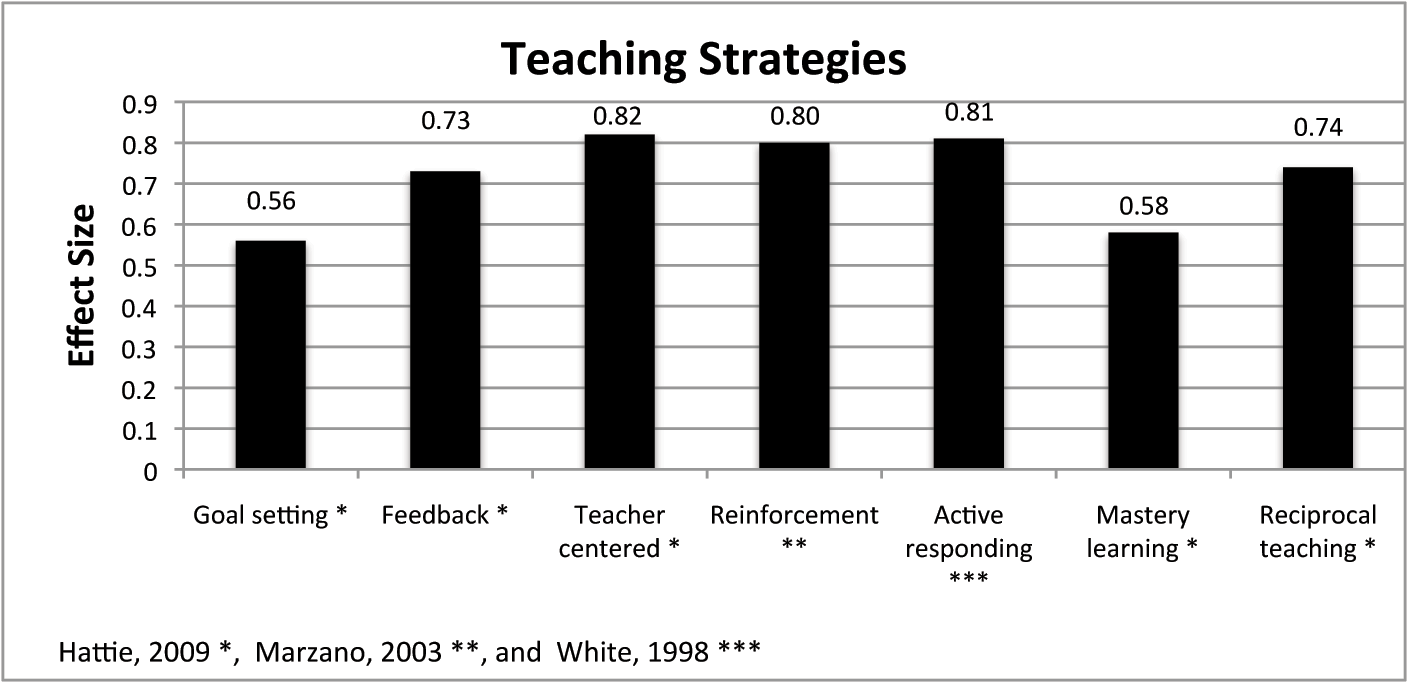What teaching strategies make a difference in improving student performance?
Why is this question important? Concerns regarding the underperformance of the American education system have been regularly affirmed since the 1983 call for reform, A Nation at Risk. However, American students have continued their disappointing performance. The National Assessment of Educational Progress (NAEP), the largest nationally representative and continuing assessment of what America’s students know in mathematics, reading, science, writing, the arts, civics, economics, geography, and U.S. history, consistently reports students performing below expectations. In response, the federal Department of Education and the individual states have spent billions of dollars to improve student test scores primarily through structural interventions such as class size reduction, school size reduction, charter schools, school vouchers, and accountability through high-stakes testing. Unfortunately, the results achieved through these interventions have been discouraging, as test scores remained virtually flat. The question should be asked, have we been focusing on the wrong interventions? Might interventions designed to improve classroom instruction provide better results?
See further discussion below.

Source(s): (1) Visible Learning: A Synthesis of Over 800 Meta-Analyses Relating to Achievement, 2009; (2) Classroom Instruction That Works: Research-Based Strategies for Increasing Student Achievement, 2001; and (3) A Meta-Analysis of the Effects of Direct Instruction in Special Education, 1998.
Result(s):
- Visible Learning
This book provides data strongly suggesting that effective practices are available to make significant differences in student achievement. The data highlights critical areas in which teachers and teaching impact on student success. - Classroom Instruction That Works
- This book consists of meta-analyses of common classroom practices to identify the effect size of critical components of effective classroom instruction and their impact on achievement. The areas covered include:
- After school programs
- Assessment and accountability
- Early childhood education
- Education technology
- Instruction strategies
- Leadership and organization development
- Literacy
- Mathematics
- School Improvement and reform
- Science
- Standards
- Teacher preparation
- Use of data
- A Meta-Analysis of the Effects of Direct Instruction in Special Education
This journal article of consists of an examination of studies that reviewed the effectiveness of direct instruction (DI) and the components that make up DI. Special education students were the focus of the study. The meta-analysis compared direct instruction to comparable instructional practices. Fifty-three percent of the outcomes significantly favored direct instruction and none of the studies showed results favoring comparison groups.
Implication(s): By focusing school reform on proven practices that achieve results in the classroom, educators increase the likelihood of meeting the goals established in No Child Left Behind. If schools are to accomplish these goals, it is important that teachers be trained in the skills identified in research as offering the greatest prospect of producing results.
Author(s): (1) John Hattie; (2) R. J. Marzano, J. S. Marzano, and D. J. Pickering; and (3) W. A. T. White.
Publisher(s): (1) Routledge, (2) Association for Supervision and Curriculum Development, and (3) Education and Treatment of Children.
Study Description: (1) The book is a synthesis of over 800 meta-analyses that provide data on the effects of educational interventions on student achievement. It is based on a review of over 50,000 individual studies. (2) The book examined over 100 quantitative studies to determine the effect size of educational practices that make a difference in improving student achievement. (3) The paper examined 25 studies on the effectiveness of direct instruction programs with special education students.
Definition(s):
- Active responding: A teaching strategy in which students are required to talk, write, solve problems, or otherwise respond at a high rates to the teacher’s instruction.
- Direct instruction (DI): DI is a method of teaching related to mastery learning, but more precise in curriculum design and instructional delivery. The term direct instruction can refer to the commercial instructional programs or the term can refer to the core components that comprise the method.
Core components of direct instruction include:
- Scripted lesson plans
- Clear communication
- Signal-based teachers (teacher signals to learners used to prompt student responding)
- Sequenced skill presentation and acquisition
- Appropriate pacing
- Active responding
- Frequent probing/testing and assessments
- Teaching to mastery
- Effect size: A standardized measure of the effect of an intervention (treatment) on an outcome. The effect size represents the change (measured in standard deviations) in an average outcome that can be expected if that person is given the treatment. Because effect sizes are standardized, they can be compared across studies.
Citation:
Hattie, J., (2009). Visible learning: A synthesis of over 800 meta-analyses related to achievement. New York: Routledge.
Marzano, R., Pickering, D., & Pollock, J. (2001). Classroom instruction that works: Research-based strategies for increasing student achievement. Alexandria, VA: Association for Supervision and Curriculum Development.
White, W. A. T., (1998). A meta-analysis of the effects of direct instruction in special education. Education and Treatment of Children, 11, 364–374.
